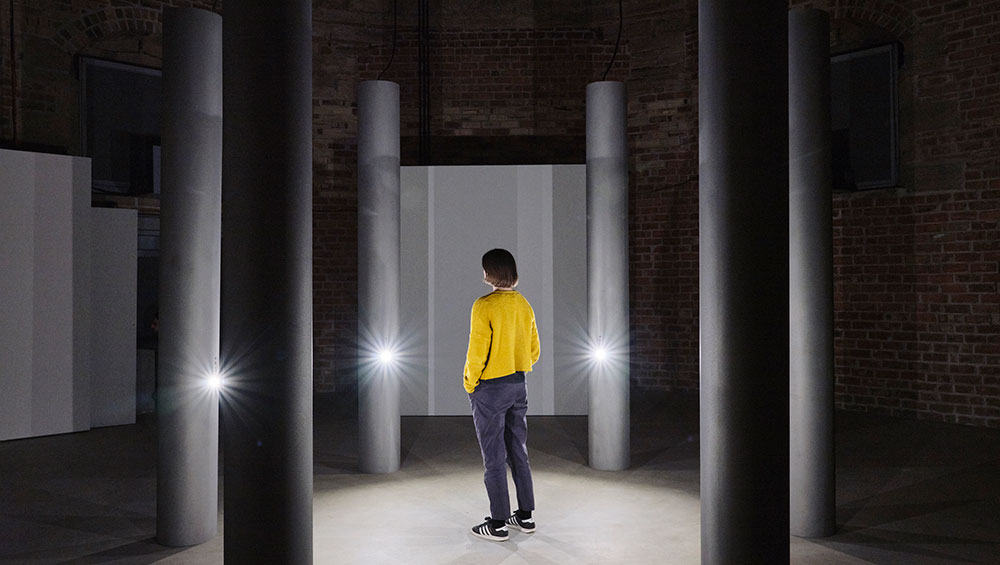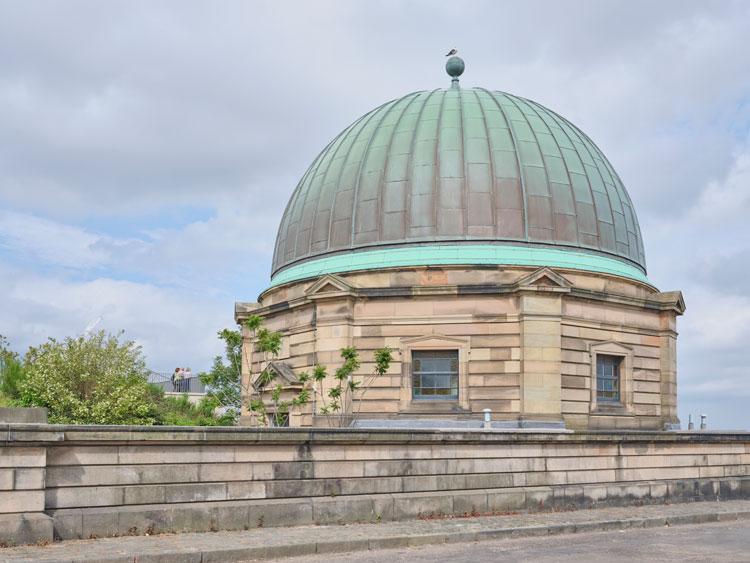
Julijonas Urbonas, A Planet of People, 2020. Installation view, Collective, Edinburgh. Photo: Tom Nolan.
Collective, Edinburgh
29 February – 8 May 2020
by CHRISTIANA SPENS
Collective’s home at the restored City Observatory on Calton Hill in Edinburgh, established so the public can view contemporary art in “a new type of city observatory”, is the ideal place in which to become immersed in its latest exhibition, Julijonas Urbonas’s Planet of People. Urbonas’s project, which is part of the Edinburgh Science Festival 2020 and forms the Lithuanian Space Agency’s special programme at this year’s 17th Venice Architecture Biennale, is a fascinating fusion of science and visual art, creating a form of conceptual art grounded (or elevated) in cutting-edge research.

Collective, City Dome, 2020. Photo: Tom Nolan.
Walking up Calton Hill on an early spring day, towards the City Observatory, it is possible to see not just Edinburgh, but Fife and beyond. The dome, which originally housed a large telescope that enabled astronomers to study the stars and planets, now welcomes visitors in to view Urbonas’s project and become a part of it. Informed by the Lithuanian artist’s interests in postphenomenology, space medicine, particle physics and outer space anthropology, and following on from other of his imaginative and innovative experiments and ideas – such as making “space vodka”, or literal “moonshine”, and an asteroid made of people – Planet of People presents a “feasibility study” of the creation of an artificial planet made entirely from human bodies. An experiment in concept and engineering, this work invites visitors to be scanned by one of six 3D scanners and then watch as their bodies appear to float around on the surface of the dome, gradually forming a new celestial object.
According to Urbonas, in his talk at the exhibition preview, Planet of People is based on the idea of sending humans to L2, one of the “Lagranian points” in space where there is no gravity, allowing frozen bodies to float around freely until they converge into a mass. As such, a new planet made of human bodies is extra-terraformed. This becomes, then, a “cosmic fossil of humanity” and the artwork itself is a monument of humans to humans.
.jpg)
Julijonas Urbonas, A Planet of People, 2020. Installation view, Collective, Edinburgh. Photo: Tom Nolan.
The project also implicitly speculates on the aesthetic, ethical and scientific issues surrounding such a structure, and how one could be choreographed, and also on what it means to be human, or a body, in such an experimental space. Are the bodies only bodies, or are they people, too? What does it say about humanity, ego and selfhood, that we could, in certain circumstances, converge in such a way? Where are the minds in this simulated planet, or do they dissolve at some point of metaphysical detachment?
Looking up from the floor of the dome and watching the bodies float around, you could say that visitors are given an “out-of-body experience”. We see images of ourselves travelling around randomly, converging with others. It is quite meditative and dissociative; for a moment we have been removed from ourselves. I see my son’s jacket floating around in space, as if he were a little astronaut or star. My boyfriend and I are there, too, although, as we are wearing black, we are harder to see. As more people come in and are scanned, the constellation of bodies grows, and the pattern of movement changes.
A spectacle and an astrophysical simulation at once, Planet of People fuses science and art in a form of “gravitational aesthetics”, as the artist describes his approach, aiming to simulate manipulations of gravity to create experiences that open our minds to the possibilities of astrophysics and to question the wider philosophical implications. In negotiating gravity, as it were, Urbonas deconstructs our assumptions about humanity and life, allowing simulations of our bodies to float freely, but also our thoughts, gently guided by metaphysical ideas and queries, as well as an infectious sense of creativity and play. Setting the bar high for conceptual, immersive art, Urbonas shows that scientific research can fuel a higher level of imagination and creativity in a setting such as this, especially when the artist is genuinely knowledgable and curious about the subject and its wider implications.